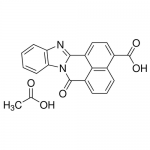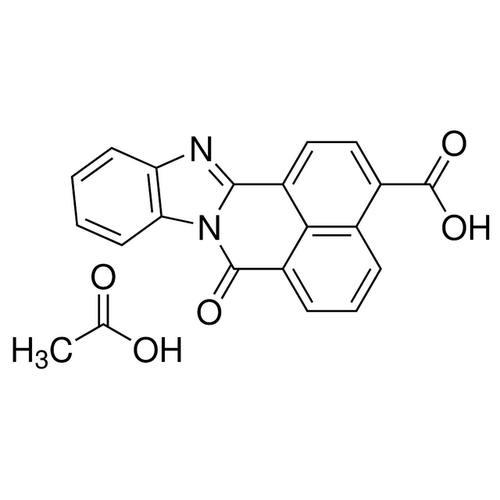| Product Name | STO 609 |
| Description |
CAMKK kinase inhibitor |
| Purity | >98% (TLC) |
| CAS No. | 52029-86-4 |
| Molecular Formula | C21H14N2O5 |
| Molecular Weight | 374.3 |
| Field of Use | Not for use in humans. Not for use in diagnostics or therapeutics. For in vitro research use only. |
Properties
| Storage Temperature | -20ºC |
| Shipping Temperature | Shipped Ambient |
| Product Type | Inhibitor |
| Solubility | Soluble in DMSO (10 mg/ml) |
| Source | Synthetic |
| Appearance | Yellow solid |
| SMILES | CC(=O)O.C1=CC=C2C(=C1)N=C3N2C(=O)C4=CC=CC5=C(C=CC3=C54)C(=O)O |
| InChI | InChI=1S/C19H10N2O3.C2H4O2/c22-18-13-5-3-4-10-11(19(23)24)8-9-12(16(10)13)17-20-14-6-1-2-7-15(14)21(17)18;1-2(3)4/h1-9H,(H,23,24);1H3,(H,3,4) |
| InChIKey | WNRSTFUVBWNELX-UHFFFAOYSA-N |
| Safety Phrases |
Classification: Not a hazardous substance or mixture. Safety Phrases: S22 - Do not breathe dust. S24/25 - Avoid contact with skin and eyes. S36/37/39 - Wear suitable protective clothing, gloves and eye/face protection. |
| Cite This Product | STO 609 (StressMarq Biosciences Inc., Victoria BC CANADA, Catalog # SIH-479) |
Biological Description
| Alternative Names | 7-Oxo-7H-benzimidazo[2,1-a]benz[de]isoquinoline-3-carboxylic acid, acetate salt |
| Research Areas | Apoptosis, Cancer, Cancer Growth Inhibitors, Cell Signaling, Tyrosine Kinase Inhibitors |
| PubChem ID | 16760660 |
| Scientific Background | STO 609 is a potent, competitive, and selective inhibitor of Ca²⁺/calmodulin-dependent protein kinase kinase (CaM-KK). It binds to the catalytic domain of CaMKK and inhibits its autophosphorylation. In neurodegenerative disease research, STO 609 is used to investigate calcium signaling pathways involved in neuronal plasticity, metabolism, and survival. CaMKK signaling is implicated in neuroinflammation and neurodegeneration, making STO 609 a valuable tool for dissecting calcium-dependent regulatory mechanisms in the brain. It is cell-permeable and widely used in both in vitro and in vivo models. |
| References |
1. Tokumitsu, H., et al. (2002) J. Biol. Chem. 277(18): 15813–15818. 2. Levine Y.C., Li G.K., & Michel T. (2007) J. Biol. Chem. 282(28): 20351–20364. 3. Anderson K.A., et al. (2008) Cell Metabolism. 7(5): 377–388. |



Reviews
There are no reviews yet.